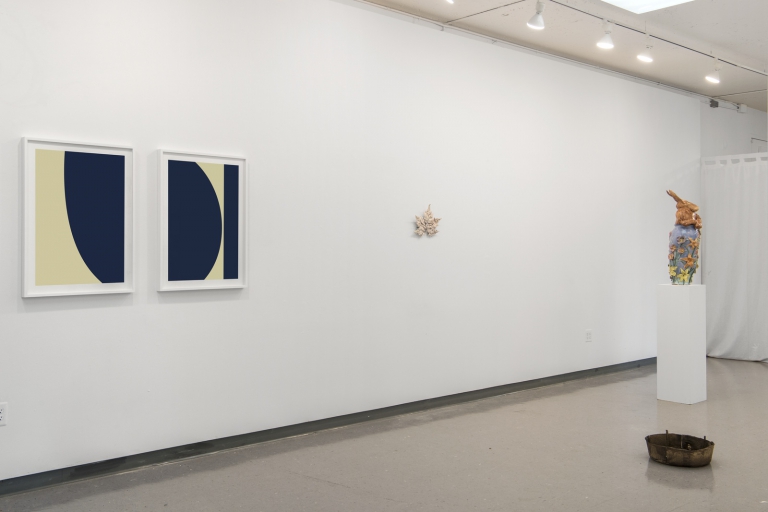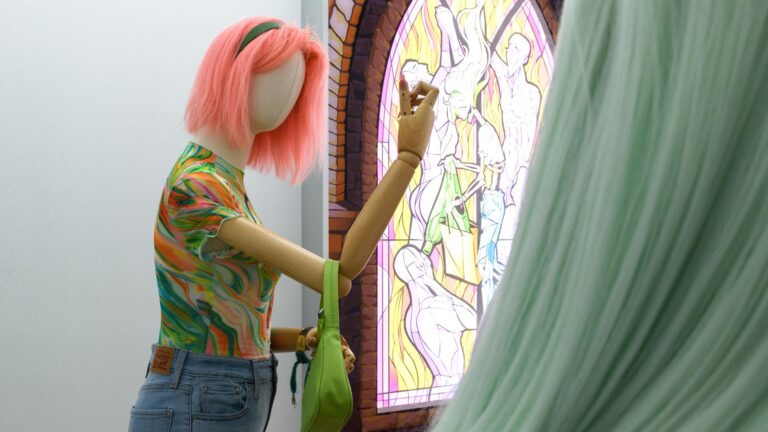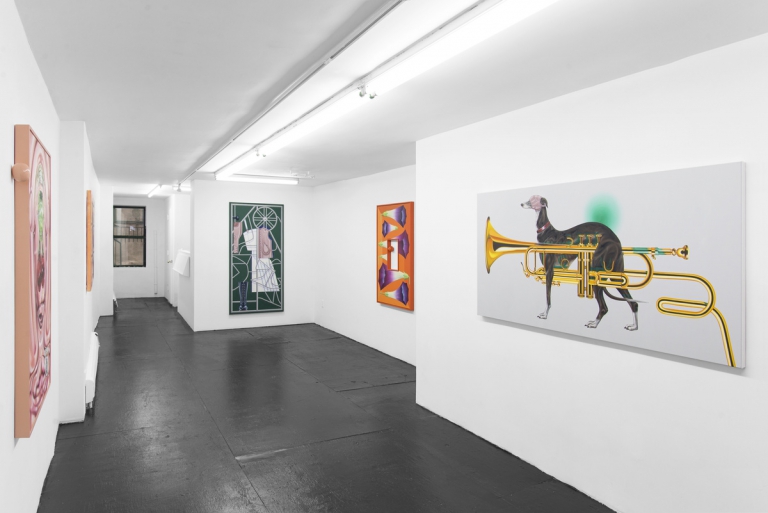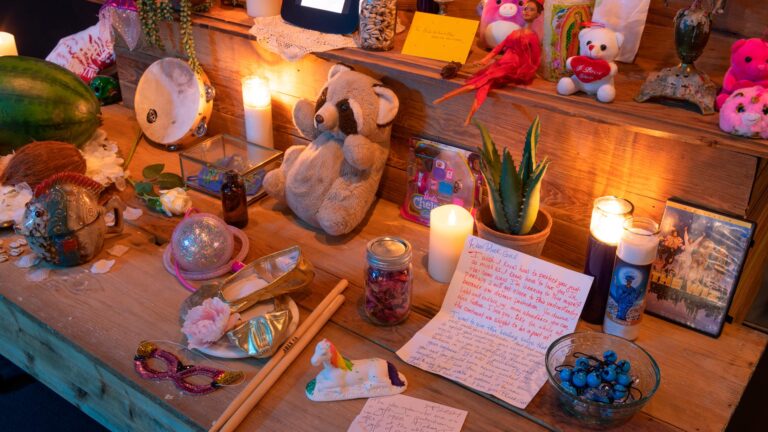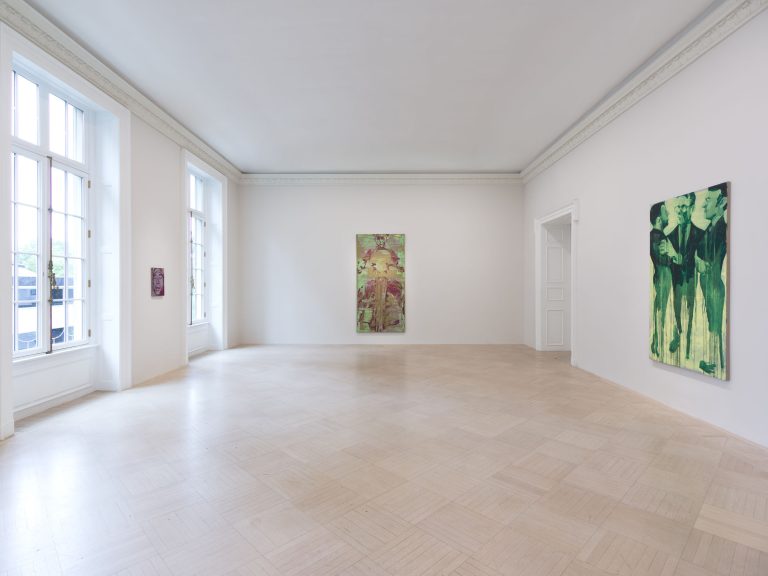Artists: Masaomi Yasunaga and Kunié Sugiura
Venue: Nonaka-Hill, Los Angeles, US
Date: June 1 – July 20, 2019
Photography: images copyright and courtesy of the artists and Nonaka-Hill, Los Angeles
Masaomi Yasunaga
(Born 1982, Osaka Japan. Living and working in Iga, Mie Prefecture, Japan)
In a gesture which has little precedence, Masaomi Yasunaga removed clay from his ceramic forms, and builds his sculptures using glaze as the primary structural element. At Nonaka-Hill, the artist’s first solo exhibition outside of Asia, Yasunaga presents numerous recent sculptures expressing a variety of vessel forms, placed on a bed of common gravel.
Yasunaga studied ceramics under Satoru Hoshino, a second-generation proponent of the avant-garde ceramic group, Sodeisha (in kanji, 走泥社 literally means, crawling through the mud). Founded in Kyoto in 1948, in the aftermath of WWII, Sodeisha broke away from long-established conventions of Japanese ceramics, resolving to create non-functional sculptural works. Continuing with this ethos, Yasunaga’s sculptures of vessels may or may not be functional, and explore an instable boundary between functional and fine arts.
By sculpting in glaze, Yasunaga’s works reimagine the use of ceramics’ conventional materials. Glaze, most commonly used to apply color, luster and finish onto the surface of clay-built ceramics, responds to different variables and often produces unexpected outcomes. Unlike clay objects which maintain their original form when fired in the kiln, Yasunaga’s glaze objects melt, so they must be buried in trays of sand, soil or rocks to retain their form. Once inside the kiln, the viscous molten glaze adheres to the surrounding earthen material. After firing and cooling, Yasunaga unburies his objects in a studio process which parallels the surprises of archeological excavation, and painstakingly removes the excess sand and rocks from the interstices of the objects. The resulting artworks range from smooth to heavily encrusted.
Yasunaga’s presentation, which verges on camouflage, resembles the beds of stone from which the works emerge after the kiln. It also embraces the narratives which his objects conjure for most viewers; that the sculptures resemble artifacts excavated from the bottom of the ocean floor or buried underground amongst ancient ruins. As such, these objects, imagined to have been lost for vast periods of time and now found, retain the global vessel styles and handiwork of imagined ceramics makers (other than Yasunaga) from eons before. Some objects seem whole, while others seem broken, arousing phenomenological thinking reflected in the artwork’s titles, all which infer something that was, or is no longer; Sai (砕) means to break or collapse, Tokeru Utsuwa (溶ける器) translates to melting vessel, Dakkaku (脱穀) is defined as threshing, and Hako No Kokkaku (箱の骨格) signifies a skeleton.
Feeling that with new life or death, comes a moment when many things may change, Yasunaga responded to the passing of his grandmother ten years ago by incorporating her cremated bone remains into the glaze of his hand-crafted funerary urns. This gesture compelled him to appreciate the emotional and expressive potentials in ceramics. Three years ago, with the joy of the birth of his eldest son, Yasunaga began to hybridize his empty container forms with depictions of animals from around where he was born. Rendered in Yasunaga’s earthen materials, these Empty creatures conjure associations to numerous histories and places, and collectively form an unlikely geologic menagerie.
Yasunaga’s exploratory approach to ceramic making delves deeper than its experimentative application of materials, his sculptures give perspective to the human relationship to time.
Kunié Sugiura
(Born 1942, Nagoya, Japan. Lives and works in New York, NY)
In a practice spanning over fifty years, Kunié Sugiura has negotiated between painting and photography, discovering and expanding through continual experimentation. At Nonaka-Hill, the artist’s first solo exhibition in Los Angeles, Sugiura presents hand-painted photo-canvases from her current Minerals series interspersed with her earliest experimental Cko series photographs from 1966-67, and a 1994 photogram/sculpture installation dedicated to her beloved pet catfish, Namu.
After realizing the limited prospects for a science career in 1960’s Japan, Sugiura enrolled at the School of the Art Institute of Chicago and majored in photography under the tutelage of Kenneth Josephson, known for his conceptual photography. Josephson had studied with Aaron Siskind at Illinois Institute of Technology’s Institute of Design, which stemmed from the New Bauhaus School, founded by László Maholy-Nagy. With this lineage, S.A.I.C. was a rich pedagogical ground for experimentative projects, and through her expansive engagement with the medium of photography, Kunie Sugiura has extended this legacy by another generation.
While in Chicago, Sugiura produced the Cko series (pronounced “ko”) from 1966-67. For these darkroom composited unique works, the artist used a wide-angle lens to encapsulate distorted nude body images inside ovoid embryonic bubbles, sometimes embedding humans into brick walls. “Ko” in Japanese could mean alone (孤), or it could also possess a more neutral connotation meaning, individual or arc (個). The Cko series reflects the artist’s ongoing interest in Existentialist literature, Kafka, Camus, and Simone de Beauvoir, as evidenced by Sugiura’s current Minerals series, also exhibited here.
Sugiura moved to New York City in 1967, arriving when Rauschenberg and Warhol were producing photo-silkscreened paintings which reflect a distinctly American popular culture point of view. Sugiura also sought to bring photography onto the same plane and scale as painting, but she worked instead from the vantage point of a recent immigrant finding a new place for herself to start from. Sugiura printed greatly enlarged close-up images of tree-trunk bark, beach pebbles and rocks in Central Park, running the image full-bleed onto canvas. These images, while expressing her solitary observations, could be seen by some as mundane, but it’s the shared-experience of such ubiquitous information which makes them, for the artist, affirmative.
For her current Mineral Series, which recalls these large photo-canvases, from 1960s & 1970s, Sugiura returned to her homeland of Japan after more than 50 years of living in the United States, seeking to reconnect and contemplate her roots. Finding herself interested in a deeper and more mysterious sense of time, she has bypassed genealogy, cities, events and histories, instead preferring to contemplate the billions of years and physical features of unobstructed, always evolving nature. Sugiura researches and photographs geologic sites, prints her images at a large (yet still intimate) scale digitally onto canvas and, with a paintbrush, begins her image exploration, finding and enhancing interesting features, applying her intervening marks. All-the-while, Sugiura meditates and fantasizes on the incomprehensible depth of time and the unknowable range of events captured but superficially by photography’s memorializing powers.
Something caught the artist’s imagination with one of her catfish subjects of her mid-1990s Animals series of photograms, which includes eels, frogs, goldfish, snails, octopi, squid, chickens and kittens. This catfish, peculiar for its small scale, became a pet called Namu, a friend and a companion. This relationship is memorialized, now 25 years later, with the presentation of his tank, activated by bubbling blue water, and three blue toned photograms which immortalize the trace movements of this intriguing creature.
Throughout her photographic practice, Sugiura has explored her personal and artistic subjectivity within the wonders of the Universal arena.
Kunié Sugiura has had numerous major solo exhibitions which include, Sugiura Kunié: Aspiring Experiments: New York in 50 Years, Tokyo Photographic Art Museum (2018), Time Emit, Visual Arts Center of New Jersey, Summit, New Jersey (2008) and Dark Matters / Light Affairs, The University of California, Davis (2001). Sugiura was featured in For a New World to Come: Experiments in Art and Photography, Japan 1968-79, Museum of Fine Arts, Houston (2015), New Photography 13, The Museum of Modern Art, New York (1997) and 1972 Annual Exhibition of Painting, Whitney Museum of American Art, New York (1972). She has received the Higashikawa Prize (2007) and the Artist’s Fellowship, New York Foundation for the Arts (1998). Her works are included in the permanent collections of the Denver Art Museum; The Museum of Fine Arts, Boston; The Museum of Modern Art, New York; and the Tokyo Metropolitan Museum of Photography.
Masaomi Yasunaga and Kunié Sugiura, 2019, exhibition view, Nonaka-Hill, Los Angeles
Masaomi Yasunaga, 2019, exhibition view, Nonaka-Hill, Los Angeles
Masaomi Yasunaga, 2019, exhibition view, Nonaka-Hill, Los Angeles
Masaomi Yasunaga, 2019, exhibition view, Nonaka-Hill, Los Angeles
Masaomi Yasunaga, 2019, exhibition view, Nonaka-Hill, Los Angeles
Masaomi Yasunaga, 2019, exhibition view, Nonaka-Hill, Los Angeles
Masaomi Yasunaga, 2019, exhibition view, Nonaka-Hill, Los Angeles
Masaomi Yasunaga, 2019, exhibition view, Nonaka-Hill, Los Angeles
Masaomi Yasunaga, 2019, exhibition view, Nonaka-Hill, Los Angeles
Masaomi Yasunaga, 2019, exhibition view, Nonaka-Hill, Los Angeles
Masaomi Yasunaga, 2019, exhibition view, Nonaka-Hill, Los Angeles
Masaomi Yasunaga, 2019, exhibition view, Nonaka-Hill, Los Angeles
Masaomi Yasunaga, 2019, exhibition view, Nonaka-Hill, Los Angeles
Masaomi Yasunaga, 2019, exhibition view, Nonaka-Hill, Los Angeles
Masaomi Yasunaga, 2019, exhibition view, Nonaka-Hill, Los Angeles
Masaomi Yasunaga, 2019, exhibition view, Nonaka-Hill, Los Angeles
Masaomi Yasunaga, 2019, exhibition view, Nonaka-Hill, Los Angeles
Masaomi Yasunaga, 2019, exhibition view, Nonaka-Hill, Los Angeles
Masaomi Yasunaga, 2019, exhibition view, Nonaka-Hill, Los Angeles
Masaomi Yasunaga, 2019, exhibition view, Nonaka-Hill, Los Angeles
Masaomi Yasunaga, 2019, exhibition view, Nonaka-Hill, Los Angeles
Masaomi Yasunaga, 2019, exhibition view, Nonaka-Hill, Los Angeles
Masaomi Yasunaga and Kunié Sugiura, 2019, exhibition view, Nonaka-Hill, Los Angeles
Kunié Sugiura, 2019, exhibition view, Nonaka-Hill, Los Angeles
Kunié Sugiura, 2019, exhibition view, Nonaka-Hill, Los Angeles
Kunié Sugiura, 2019, exhibition view, Nonaka-Hill, Los Angeles
Kunié Sugiura, 2019, exhibition view, Nonaka-Hill, Los Angeles
Kunié Sugiura, 2019, exhibition view, Nonaka-Hill, Los Angeles
Kunié Sugiura, 2019, exhibition view, Nonaka-Hill, Los Angeles
Kunié Sugiura, 2019, exhibition view, Nonaka-Hill, Los Angeles
Kunié Sugiura, 2019, exhibition view, Nonaka-Hill, Los Angeles
Kunié Sugiura, 2019, exhibition view, Nonaka-Hill, Los Angeles
Kunié Sugiura, 2019, exhibition view, Nonaka-Hill, Los Angeles
Kunié Sugiura, 2019, exhibition view, Nonaka-Hill, Los Angeles
Kunié Sugiura, 2019, exhibition view, Nonaka-Hill, Los Angeles




































